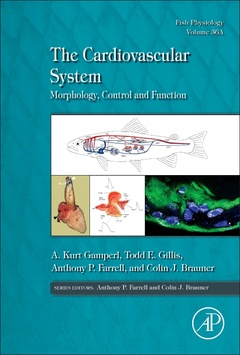The Cardiovascular System Morphology, Control and Function Fish Physiology Series

The Cardiovascular System: Design, Control and Function, Volume 36A, a two- volume set, not only provides comprehensive coverage of the current knowledge in this very active and growing field of research, but also highlights the diversity in cardiovascular morphology and function and the anatomical and physiological plasticity shown by fish taxa that are faced with various abiotic and biotic challenges. Updated topics in this important work include chapters on Heart Morphology and Anatomy, Cardiomyocyte Morphology and Physiology, Electrical Excitability of the Fish Heart, Cardiac Energy Metabolism, Heart Physiology and Function, Hormonal and Intrinsic Biochemical Control of Cardiac Function, and Vascular Anatomy and Morphology.
In addition, chapters integrate molecular and cellular data with the growing body of knowledge on heart and in vivo cardiovascular function, and as a result, provide insights into some of the most important questions that still need to be answered.
Jose Icardo
2. Cardiomyocyte Morphology and Physiology
Holly Alice Shiels
3. Cardiac Excitiabiity and its Autonomic Regulation
Matti Vornanen
4. Heart Physiology and Function
Anthony P. Farrell and Frank Melvin Smith
5. Hormonal and Autacoid Control of Cardiac Function
Sandra Imbrogno and Maria Cerra
6. Cardiac Energy Metabolism
Ken Rodnick and Hans Gesser
7. Form, Function and Control of the Vasculature
Erik Sandblom and Albin Gräns
Dr. Todd Gillis was educated in Canada at the University of Guelph (BSc, MSc) and Simon Fraser University (PhD). His PhD thesis focused on the mechanisms that enable cardiac function in rainbow trout at their comparatively low physiological temperature. As a Natural Sciences and Engineering Research Council (NSERC) Post-Doctoral Fellow at the University of Washington, he studied the role of the thin filament in controlling cardiac function. Dr Gillis’ research program, funded by NSERC, and Fisheries and Oceans Canada is focused on the vertebrate heart and the mechanisms that regulate its function, and capacity to respond to environmental and pathological stressors including temperature change, hypoxia, injury, and oil exposure. This work utilizes an integrative approach that is linking changes in gene and protein expression to cellular and tissue function to whole animal responses. Dr. Gillis is an Associate Editor of the Journal of Comparative Physiology B and on the Editorial Boards of the Journal of Thermal Biology, Comparative Biochemistry and Physiology A, and Current Research in Physiology.
Dr. Tony Farrell is a Professor Emeritus in the Department of Zoology & Faculty of Land and Food Systems at the University of British Columbia and a Fellow of the Royal Society of Canada. His research had provided an understanding of fish cardiorespiratory systems and has applied this knowledge to salmon migratory passage, fish stress handling and their recovery, sustainable aquaculture and aquatic toxicology. He has over 490 research publications in peer-reviewed scientific journals
- Presents a comprehensive overview of cardiovascular structure and function in fish
- Covers topics in a way that is ideal for researchers in fish physiology and for audiences within the fields of comparative morphology, histology, aquaculture and ecophysiology
- Provide insights into some of the most important questions that still need to be answered
Date de parution : 08-2017
Ouvrage de 478 p.
15x22.8 cm



